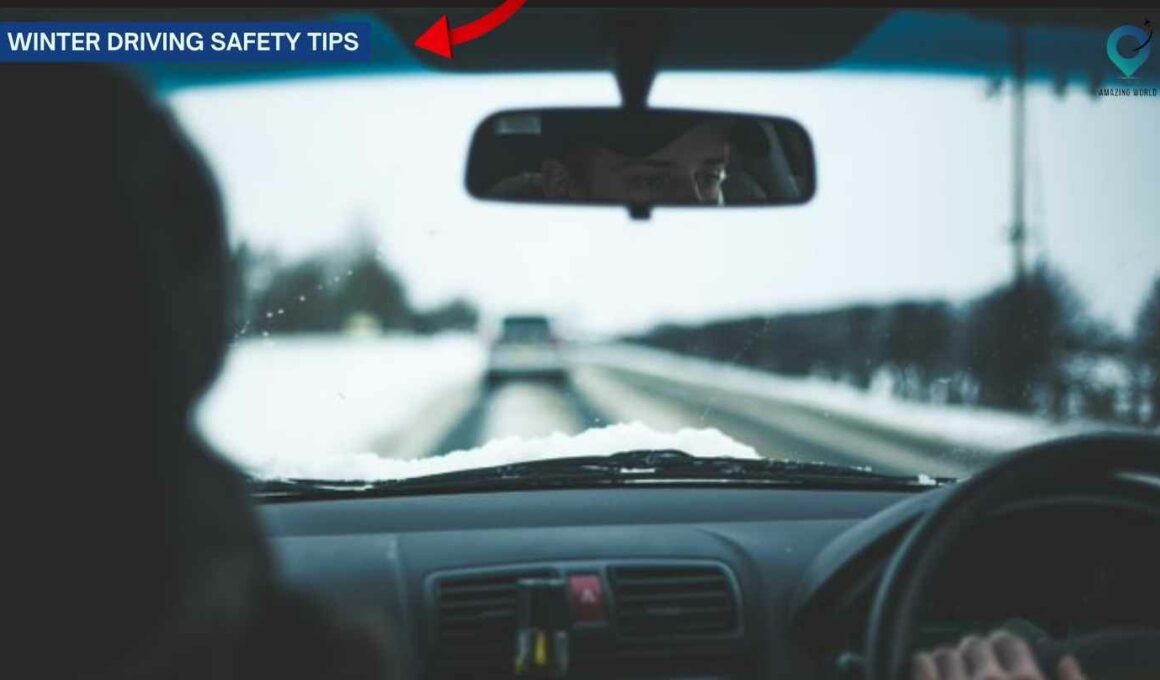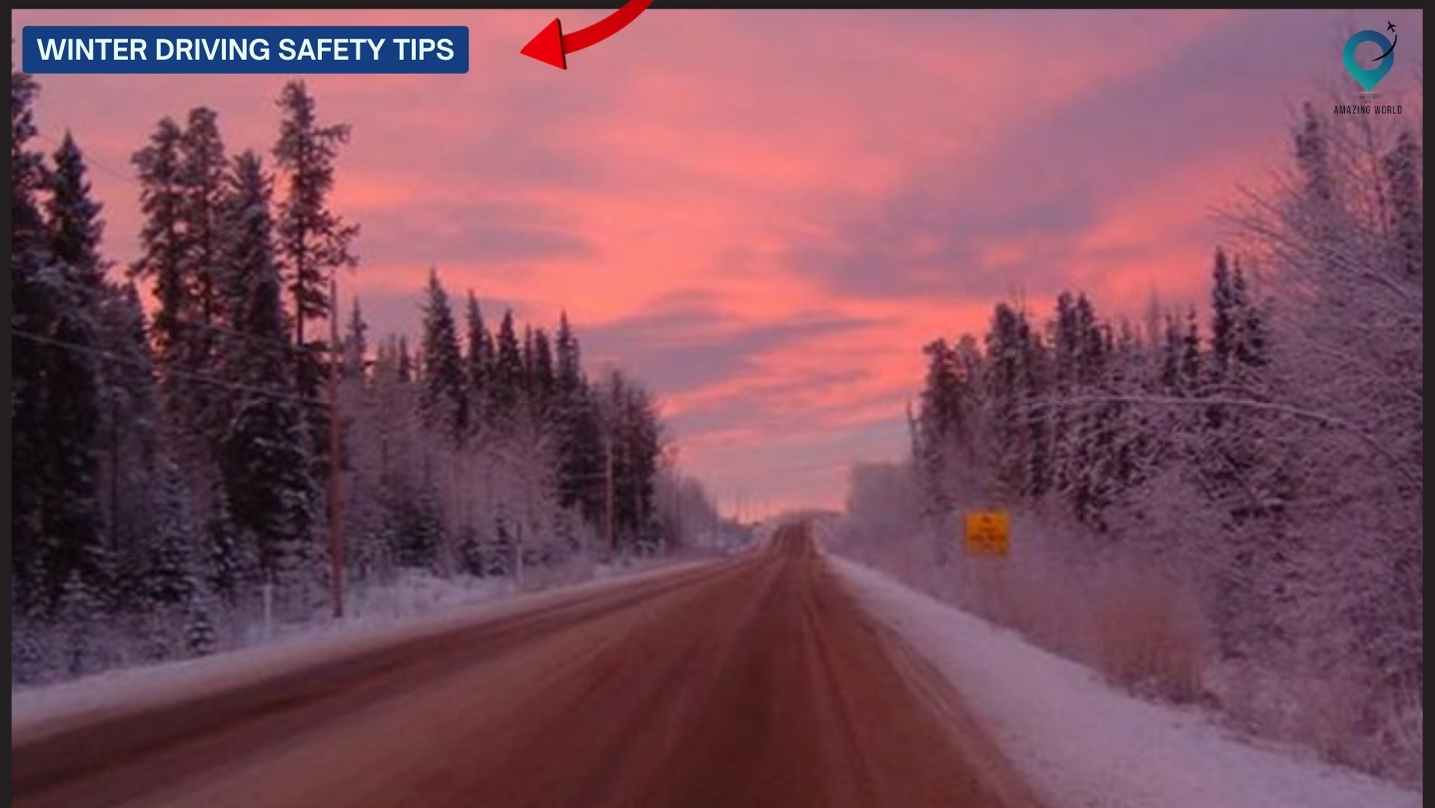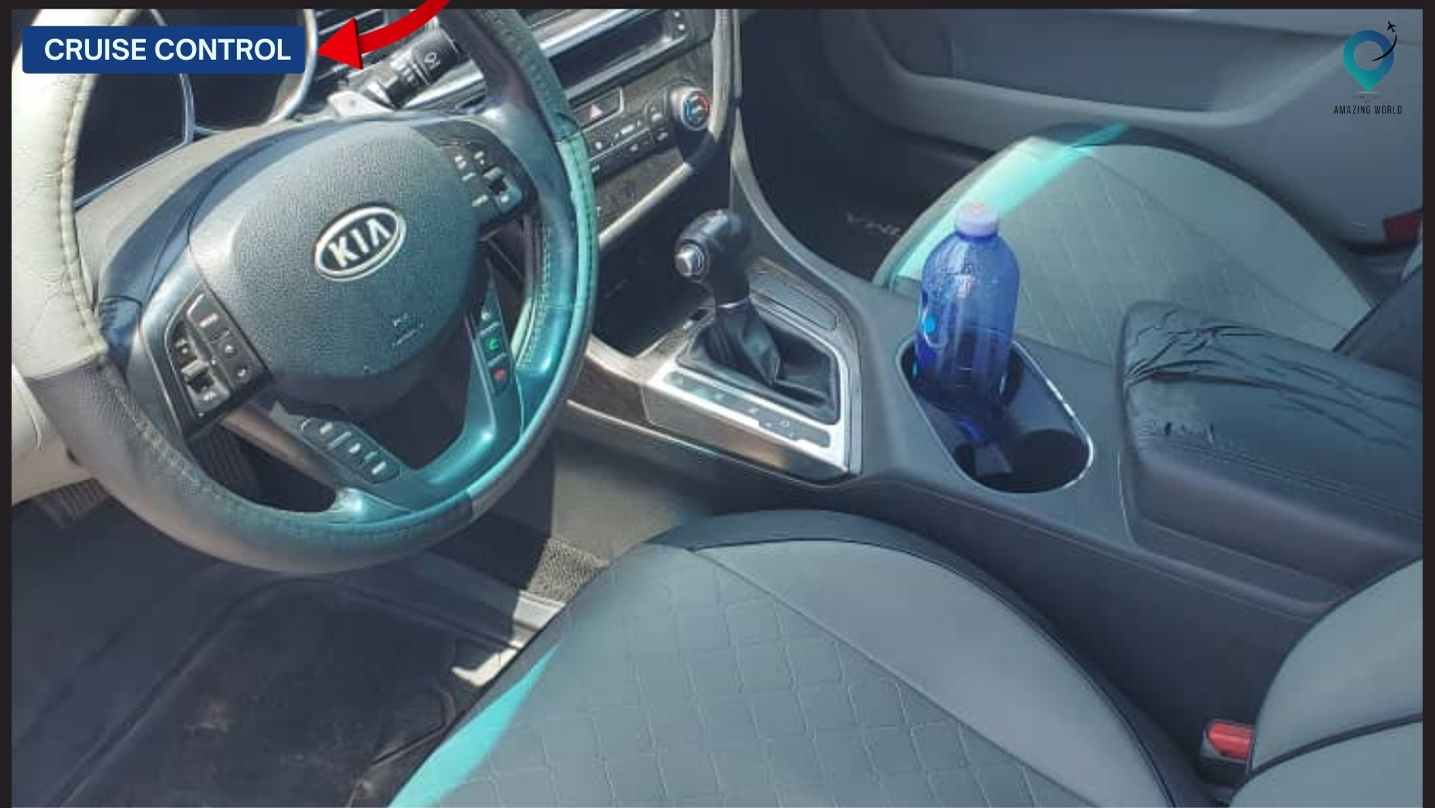12 Essential Winter Driving Safety Tips | Expert Tips in 2024
Are you ready to tackle the challenges of winter driving with confidence? As temperatures drop and snowflakes begin to fall, it’s crucial to equip yourself with the knowledge and tools necessary to navigate safely on icy roads.
In this guide, we’ll unveil 12 essential winter driving safety tips, curated by experts to help you steer through the season with ease. From preparing your vehicle for frosty conditions to mastering the art of gentle braking, we’ve got you covered. So, buckle up and join us as we explore the essential strategies for staying safe behind the wheel when the mercury dips.
1. Check weather conditions before driving.
Checking weather conditions before driving is essential for ensuring safety on the road. By staying informed about the weather forecast, you can anticipate potential hazards such as snowstorms, icy roads, or heavy rain.
This allows you to plan your journey accordingly, possibly adjusting your route or delaying your trip if conditions are unsafe. Being aware of the weather helps you make informed decisions to avoid accidents and reach your destination safely.
2. Prepare your vehicle adequately.
Preparing your vehicle adequately is crucial for safe driving, especially in winter conditions. This involves several steps, including:
- Checking tire pressure and ensuring tires are properly inflated for optimal traction.
- Ensuring your vehicle’s fluids, such as antifreeze, are at appropriate levels to prevent freezing.
- Having a full tank of gas to avoid the risk of running out in cold weather.
- Inspecting brakes, lights, windshield wipers, and defrosters to ensure they are in good working condition.
- Equipping your vehicle with necessary items like an ice scraper, shovel, jumper cables, and emergency supplies in case of a breakdown.
- Consider installing winter tires for improved traction on snow and ice.
By adequately preparing your vehicle, you reduce the risk of mechanical failures and increase your safety while driving in winter.
3. Slow down and increase the following distance.
Slowing down and increasing the following distance between your vehicle and the one in front of you is crucial for safe driving, especially in adverse weather conditions.
When you slow down, you give yourself more time to react to unexpected situations, such as sudden stops or slippery road conditions. Additionally, increasing the following distance allows for more space between vehicles, reducing the risk of rear-end collisions and providing ample time to brake safely.
By adhering to these practices, you can maintain better control of your vehicle, mitigate the risk of accidents, and ensure the safety of yourself and others on the road.
4. Consider using winter tires for better traction.
Winter tires are specially designed to provide better traction and handling in cold weather conditions, including snow, ice, and slush. Unlike all-season tires, winter tires are made with a softer rubber compound that remains flexible in low temperatures, allowing them to grip the road more effectively. Additionally, winter tires feature deeper tread patterns and unique tread designs with sipes (small cuts in the tread blocks) to bite into snow and ice, enhancing traction and braking performance.
Using winter tires significantly improves your vehicle’s ability to navigate through winter hazards, reducing the risk of skidding, sliding, and losing control. This enhanced grip helps you accelerate, brake, and maneuver more safely on slippery surfaces, ultimately enhancing overall driving safety during the winter months.
It’s important to note that while all-wheel drive (AWD) or four-wheel drive (4WD) vehicles can improve traction, they do not provide the same level of grip as winter tires on snow and ice. Therefore, equipping your vehicle with winter tires remains the most effective way to enhance winter driving safety.
5. Brake gently to avoid skidding.
Braking gently is essential to prevent skidding, especially in slippery road conditions like snow or ice. When you apply sudden or forceful braking, the wheels can lock up, causing your vehicle to lose traction and slide uncontrollably.
By braking gently, you allow the wheels to maintain some level of rotation, which helps preserve traction with the road surface. This gradual braking action allows the tires to grip the road more effectively, reducing the likelihood of skidding and helping you maintain control of your vehicle.
Furthermore, if your vehicle is equipped with an anti-lock braking system (ABS), gentle braking enables the ABS to function properly. ABS systems automatically modulate braking pressure to prevent wheel lock-up and maintain steering control during emergency braking situations, further enhancing safety on slippery roads.
6. Avoid using cruise control.
Avoiding the use of cruise control is important, especially in winter driving conditions. Cruise control is designed to maintain a constant speed set by the driver, but it can be problematic on slippery roads for several reasons.
Firstly, cruise control can cause your vehicle to accelerate unexpectedly when it encounters icy or slippery patches, as it tries to maintain the set speed. This sudden acceleration can lead to loss of traction and potential loss of control.
Secondly, when driving in winter conditions, it’s essential to maintain full control over your vehicle’s speed, acceleration, and deceleration. By keeping your foot on the accelerator pedal, you’re better able to react quickly to changing road conditions, such as patches of black ice or sudden obstacles.
Lastly, using cruise control can lull drivers into a false sense of security, leading to decreased attentiveness and slower reaction times in emergencies.
Therefore, it’s safer to avoid using cruise control in winter driving conditions and instead maintain manual control over your vehicle’s speed, allowing you to respond effectively to the ever-changing road conditions.
7. Stay alert and aware of your surroundings.
Staying alert and aware of your surroundings is vital for safe driving, especially in challenging conditions like winter weather.
Remaining vigilant allows you to anticipate potential hazards such as icy patches, reduced visibility, or other drivers’ actions. By staying focused on the road and your surroundings, you can react quickly to unexpected situations, such as sudden stops or swerving vehicles.
Furthermore, being aware of your surroundings involves constantly scanning the road ahead, checking mirrors, and monitoring traffic around you. This helps you maintain situational awareness and proactively adjust your driving to ensure safety.
Additionally, staying alert means avoiding distractions such as texting, talking on the phone, or adjusting the radio while driving. These distractions can significantly impair your ability to react to dangers on the road.
8. Pack a winter survival kit in your vehicle.
Packing a winter survival kit in your vehicle is essential for staying safe during cold weather and potential emergencies. This kit should include items to help you stay warm, hydrated, and visible in case you become stranded or encounter difficulties on the road. Some essential items to include in a winter survival kit are:
| Item | Description |
| Blankets or Sleeping Bags | Keep warm in case of prolonged exposure to cold. |
| Non-perishable Food | Energy bars, canned goods for sustenance if stranded. |
| Bottled Water | Hydration is essential; pack enough for all passengers. |
| First-Aid Kit | Treat minor injuries quickly and effectively. |
| Flashlights | Provide visibility at night; pack extra batteries. |
| Emergency Flares/Reflective Triangles | Signal for help if stranded or in distress. |
| Basic Tools | Multi-tool or wrench for minor vehicle repairs. |
| Jumper Cables | Restart your vehicle if the battery dies. |
| Shovel | Clear snow or debris around your vehicle. |
| Traction Aids | Sand, kitty litter, or traction mats for grip. |
| Extra Clothing | Gloves, hats, socks for warmth if stranded. |
| Fully Charged Cell Phone | Stay connected and call for help if needed. |
| Portable Charger | Keep your devices charged for communication. |
9. Clear all snow and ice from your vehicle before driving.
| Item | Description |
| Snow Brush/Ice Scraper | Remove snow and ice from windows, mirrors, and lights. |
| Snow Shovel | Clear snow from the roof, hood, and trunk of the car. |
| De-Icer Spray | Help melt stubborn ice on windows and locks. |
| Gloves | Protect your hands from cold while clearing snow/ice. |
| Safety Vest | Increase visibility to other drivers while working. |
10. Ensure proper lighting for visibility.
Ensuring proper lighting for visibility is crucial for safe driving, particularly in low-light conditions or during inclement weather. Adequate lighting not only allows you to see the road clearly but also makes your vehicle more visible to other drivers, reducing the risk of accidents.
Firstly, headlights play a vital role in illuminating the road ahead, providing essential visibility for nighttime driving and in adverse weather such as fog or heavy rain. Properly functioning headlights allow you to detect obstacles, pedestrians, or wildlife on the road, enabling you to react promptly and avoid potential hazards.
Additionally, taillights, brake lights, and turn signals are essential for signaling your intentions to other drivers. Taillights make your vehicle visible from behind, while brake lights alert drivers behind you when you’re slowing down or stopping. Turn signals indicate your intention to change lanes or make a turn, enhancing communication and preventing collisions.
11. Stay informed about road conditions.
Staying informed about road conditions is essential for safe and efficient travel, especially during challenging weather or unforeseen circumstances. By remaining updated on road conditions, drivers can anticipate potential hazards and adjust their routes or driving behaviors accordingly, minimizing the risk of accidents or delays.
One of the primary ways to stay informed about road conditions is through various sources of information, such as traffic reports, weather forecasts, and navigation apps. Traffic reports provide real-time updates on accidents, road closures, or congestion, allowing drivers to plan alternate routes and avoid potential delays.
Additionally, monitoring weather forecasts helps drivers prepare for adverse weather conditions, such as snowstorms, heavy rain, or high winds. By knowing what weather conditions to expect, drivers can adjust their driving habits, such as reducing speed or increasing following distance, to ensure safety on the road.
Navigation apps, equipped with real-time traffic data and incident reports, also play a crucial role in keeping drivers informed about road conditions. These apps provide up-to-date information on traffic flow, construction zones, and accidents, helping drivers make informed decisions about their travel routes and schedules.
Furthermore, listening to radio broadcasts or checking social media channels can provide additional updates on road conditions, especially during emergencies or severe weather events. Sharing information with other drivers about road closures, accidents, or hazardous conditions can contribute to a safer driving environment for everyone on the road.
12. Consider staying home if conditions are severe.
Considering staying home if conditions are severe is a crucial safety measure for drivers facing challenging weather or hazardous road conditions. When weather conditions pose a significant risk to road safety, such as heavy snowfall, ice storms, or severe flooding, the safest option may be to avoid traveling altogether.
By choosing to stay home during severe weather events, drivers can protect themselves and others from potential accidents, injuries, or getting stranded on the road. Additionally, staying off the roads reduces the burden on emergency services and road maintenance crews, allowing them to focus on clearing roads and assisting those in need more effectively.
Before deciding to stay home, it’s essential to assess the severity of the weather conditions and consider whether the trip is truly necessary. Alternative options, such as telecommuting, rescheduling appointments, or delaying travel plans, may be viable alternatives to venturing out in dangerous conditions.
Conclusion.
Winter driving presents unique challenges that require careful preparation and adherence to safety guidelines. By following essential winter driving safety tips, including checking weather conditions, preparing your vehicle, adjusting your driving habits, and staying informed about road conditions, drivers can reduce the risk of accidents and ensure safer travel during the colder months.
Key practices such as slowing down, maintaining proper following distances, avoiding distractions, and staying alert to changing road conditions are vital for navigating safely through snow, ice, and other winter hazards. Additionally, equipping your vehicle with winter tires, packing a winter survival kit, and considering staying home during severe weather can further enhance safety on the road.
How much did you like Our detailed 12 Essential Winter Driving Safety Tips | Expert Tips in 2024? Review Also, please share these Blogs with your friends on social media.
Recommended
- Travel Hacks
- 12-Ways to Keep Kids Entertained
- Travel Tips for Single Parents
- Top travel tips for seniors

Meet David Hoper, a passionate travel Blog writer with 7+ years of experience in travel content. Through his exemplary storytelling and engaging narratives, he shares his experiences and brings destinations to life. With a keen eye for detail and a love for exploration, he has cultivated a diverse portfolio of travel blogs that inspire and inform readers worldwide.













